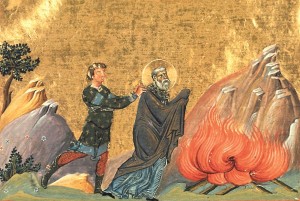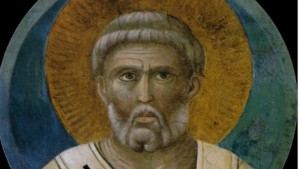 Bishop of Smyrna (Asia Minor), Polycarp was martyred between 155 and 167. Aside from an epistle he wrote to the Philippians and a letter addressed to him by Ignatius of Antioch, he is known especially for the account of his martyrdom, the first such account to be written after the narrative of Stephen’s martyrdom in the Acts of the Apostles.This extraordinary narrative was composed shortly after Polycarp’s death. Many passages should be quoted here, like this one, where the governor invites Polycarp to curse Christ. Here is the bishop’s response: “For eighty six years I have been his servant and he has done me no wrong. How can I blaspheme against my king and savior?” This text is also the first one where we find a mention of the cult of relics and of the celebration of the anniversary of the martyrdom: “Collecting the remains that were dearer to us than precious stones and finer than gold, we buried them in a fitting spot. Gathering there, so far as we can, in joy and gladness, we will be allowed by the Lord to celebrate the anniversary day of his martyrdom, both as a memorial for those who have already fought the contest and for the training and preparation of those who will do so one day.”
Bishop of Smyrna (Asia Minor), Polycarp was martyred between 155 and 167. Aside from an epistle he wrote to the Philippians and a letter addressed to him by Ignatius of Antioch, he is known especially for the account of his martyrdom, the first such account to be written after the narrative of Stephen’s martyrdom in the Acts of the Apostles.This extraordinary narrative was composed shortly after Polycarp’s death. Many passages should be quoted here, like this one, where the governor invites Polycarp to curse Christ. Here is the bishop’s response: “For eighty six years I have been his servant and he has done me no wrong. How can I blaspheme against my king and savior?” This text is also the first one where we find a mention of the cult of relics and of the celebration of the anniversary of the martyrdom: “Collecting the remains that were dearer to us than precious stones and finer than gold, we buried them in a fitting spot. Gathering there, so far as we can, in joy and gladness, we will be allowed by the Lord to celebrate the anniversary day of his martyrdom, both as a memorial for those who have already fought the contest and for the training and preparation of those who will do so one day.”
(H. Musurillo [ed.], The Acts of the Christian Martyrs, Oxford, 1972, pp. 9, 17).
Illustr.: St Polycarp. Martyrdom of St Polycarp – Menologion of Basil II (Vatican).
